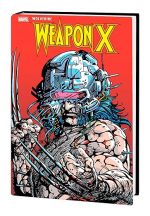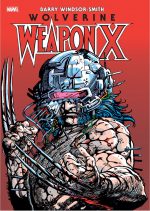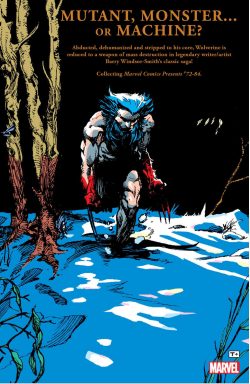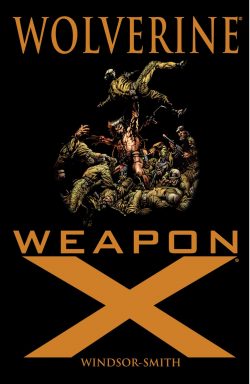
By Alf Wallace, Luis Bermejo & various (Rebellion Studios)
ISBN: 978-1-78108-758-9 (HB/Digital edition)
Gosh I feel inexplicably optimistic and upbeat this week and can’t imagine why. Let’s continue looking forward and back and explore one of our little industry’s best lost secret: a buried masterpiece of international cooperation that has stood the test of time…
Until relatively recently, Britain never really had a handle on superheroes. Although every reader from the 1950s on can cite a particular favourite fantasy muscle-man or costumed champion – from Thunderbolt Jaxon to Morgyn the Mighty to Marvelman, Gadget Man & Gimmick Kid to The Spider, Tri-Man and Phantom Viking to Red Star Robinson, The Leopard from Lime Street and Billy the Cat (& Katie!) and all worthy stalwarts deserving their own archived revivals! – who have populated our pages, they all somehow ultimately lacked conviction. Well, almost all…
During the heady Swinging Sixties days of “Batmania”, just as Marvel Comics was first infiltrating our collective consciousness, a little-remembered strip graced the pages of a short-lived experimental title. The result being sheer, unbridled magic…
With Scotland’s DC Thomson steadily overtaking the London-based competition (monolithic comics publishing giant Amalgamated Press) during the late 1950s & 1960s, the sheer variety of material the southerners unleashed to compete offered incredible vistas in adventure tales. Thanks to Leo Baxendale and Ken Reid’s defection to AP, they also had a wealth of anarchic comedy material to challenge the likes of The Bash Street Kids, Dennis the Menace, Minnie the Minx and their unruly ilk. During that latter end of the period, the Batman TV show sent the world superhero crazy just as AP finished absorbing all its local rivals such as The Eagle’s Hulton Press to form Fleetway, Odhams and ultimately IPC.
Formerly the biggest player in children’s comics, Amalgamated Press (founded by Alfred Harmsworth at the beginning of the 20th century) had stayed at the forefront of sales by latching onto every fad: keeping their material contemporary, if not always fresh or original. The all-consuming monolith had been reprinting the early successes of Marvel comics for a few years, feeding on the growing fashion for US-style action/adventure which had largely supplanted the rather tired True-Blue Brit style of Dan Dare or DCT’s Wolf of Kabul or the Tough of the Track. A key point at that time was that although both part of the Mirror Group, Fleetway and Odhams were deadly rivals…
Power Comics was a sub-brand used by Odhams to differentiate their periodicals containing reprinted American superhero material from the greater company’s regular blend of sports, war, western adventure and gag comics such as Buster, Valiant, Lion or Tiger. During this period, the strictly monochrome Power weeklies did much to popularise budding Marvel characters and their shared universe in this country, which was still poorly served by distribution of the actual American imports.
The line began with Wham! – but only after the comic was well-established. Originally created by newly-ensconced Baxendale, it had launched on June 20th 1964. Initially, the title was designed as a counter to The Beano, as was Smash! (launching February 5th 1966), but the tone of times soon dictated the hiving off into a more distinctive imprint, which was augmented by the creation of little sister Pow!
Pow! premiered with a cover date of January 31st 1967, combining home-grown funnies like Mike Higgs’ The Cloak, Baxendale’s The Dolls of St Dominic’s, Reid’s Dare-a-Day Davy, Wee Willie Haggis: The Spy from Skye and British originated thrillers such as Jack Magic and The Python with the now ubiquitous resized US strips: in this case Amazing Spider-Man, The Hulk and Nick Fury, Agent of S.H.I.E.L.D. The next step was even bolder. Fantastic – and its sister paper Terrific – were notable for not reformatting or resizing the original US artwork whereas in Wham!, Pow! or Smash!, an entire 24-page yarn could be rejigged and squeezed into 10 or 11 pages, and were accompanied by British comedy and adventure strips.
These slick new titles – each with a dynamic back cover pin-up taken from Marvel Comics or created in-house by apprentice comics bods and future superstars Barry Windsor-Smith and Steve Parkhouse (see below) – reprinted US Superhero fare, supplemented by minimal amounts of UK originated filler and editorial.
Fantastic #1 debuted with cover-date February 18th 1967 (but first seen in newsagents on Saturday 11th), revealing the origin stories of Thor, Iron Man and the X-Men, but from the get-go, savvy tykes like me were as engrossed by a short adventure serial also included to fill out the page count. The Missing Link was beautifully drawn and over the following year (February 18th 1967 – February 3rd 1968) would become a truly unique reading experience…
The series began inauspiciously as a homegrown Incredible Hulk knock off. Oddly, editor and writer Alfred “Alf” Wallace crafted for the filler a tone very similar to that adopted by Marvel’s own Green Goliath when he became a small screen star a decade later…
The illustrator was the astoundingly gifted Luis Bermejo Rojo, a star of Spanish comics forced to seek work abroad after the domestic market imploded in 1956. He became a prolific contributor to British strips, working on a succession of moody masterpieces in a variety of genres. These included The Human Guinea Pig, Mann of Battle, Pike Mason, Phantom Force Five and Heros the Spartan, appearing in Girls Crystal, Tina, Tarzan Weekly, Battle Picture Library, Thriller Picture Library The Eagle, Buster, Boys World, Tell Me Why, Look and Learn and many more. Bermejo finally achieved a modicum of his long-deserved acclaim in the 1970s, after joining fellow studio mates José Ortiz, Esteban Maroto and Leopoldo Sanchez working on adult horror stories for Creepy, Eerie and Vampirella.
I’m still a big kid helplessly enmired in nostalgia, but to me his greatest moments were the year spent drawing Johnny Future…

The Missing Link – as the feature was entitled for the first 15 episodes – was disturbingly similar in tone and delivery to television’s Hulk of the 1970s. The strip’s titular protagonist was superhumanly strong, seemingly intellectually challenged and tragically misunderstood. The saga combined human-scaled drama with lost world exoticism in the manner of King Kong, as can be see seen following Steve Holland’s incisive and informative Introduction ‘Welcome to the Future!’, when the drama opens in the wilds of Africa.
A bestial man-beast roams the veldt, swamps and mountains, until great white hunter Bull Belson comes to capture him, accompanied by secretary/photographer Lita Munro. The infamous tracker sees only profit in his quarry: a mute beast who, after much frustratingly destructive behaviour, is lured into captivity by an inexplicable attraction to Miss Munro…
To be fair, she actually has the brute’s interests at heart, attempting to befriend and teach the Link on the slow voyage back to England, but on reaching London Dock, the prospective sideshow attraction is spooked by mocking labourers and shockingly breaks his bonds… and cage.
Brutally rampaging across the city at the heart of the Swinging Sixties, the Link is hunted by the army, but no one realizes that beneath the bestial brow is a cunning brain. Hopping a freight train north, he seeks refuge in an isolated government atomic research laboratory run by Dr. Viktor Kelso and is accidentally dosed with vast amounts of transformative radiation. Unleashed uncanny forces jumpstart an evolutionary leap, turning the primitive beast into a perfect specimen of human manhood, while simultaneously sparking near-catastrophic meltdown in the machinery. It is only averted by the massive instinctive intellect of the new man. Arrested as a terrorist spy, the silent superman is very publicly tried in court and again encounters Lita.
Kelso meanwhile has deduced the true course of events. As the Link uses his prison time to educate himself in the ways of the world, the unstable scientist works on a deadly super-weapon, prompting the Link to escape jail and clear his name. With super-strength and his newly enhanced massive mind, the task is easy but he still needs Lita to complete his plan…
The series cheerfully plundered the tone of the times. The drama seamlessly morphs into and pilfers chilling contemporary science fiction tropes as Kelso’s device brings Britain to a literal standstill, leaving only the evolved outsider to thwart a staggeringly ambitious scheme.
Set on a fresh, bold openly heroic path, and despite still being a hunted fugitive, the Link creates a civilian identity (John Foster) and a costumed persona just as the nation is assaulted by ‘The Animal Man’: a psionic dictator able to control all beasts and creatures. Incredibly, that includes recently ascendant Johnny Future, with the villain only defeated through overextending himself after accidentally awakening a primordial horror from Jurassic times…
In short order, Johnny Future tackles Dr. Jarra and his killer robot; a society of evil world-conquering scientists; invention-plundering shapeshifting aliens; prehistoric giants and deranged science tyrant The Master.
Fully hitting his stride, the tomorrow man overcomes personality warping psychopath Mr. Opposite and defeats the top assassins of the Secret Society of Science – ‘The Brain, The Brute and the Hunter’, prior to saving Earth from marauding living metal and destroying Dr. Plasto’s animated waxwork killers.
… And that was that. Without warning the comic merged with sister publication Terrific and there was no more room for a purely British superhero. Here, however, there’s one final memorable delight: a 14-page, full-colour complete adventure with Johnny battling diabolical primordial revenant Disastro, as first seen in Fantastic Annual 1968, as well as a colour pin-up from Fantastic #30 (September 9th 1967).

Interest in superheroes and fantasy in general were on the wane and British weeklies were diversifying. Some switched back to war, sports and fantasy adventure yarns, whilst – with comedy strips on the rise again – others became largely humour outlets. The Complete Johnny Future is a unique beast: a blend of British B-movie chic with classic monster riffs seen through the same bleakly compelling lens that spawned Doctor Who and Quatermass. It is the social sci fi of John Wyndham trying on glamourous superhero schtick whilst blending the breakneck pace of a weekly serial with the chilling moodiness of kitchen sink crime dramas.
There was never anything quite like this before – or since – and if you love dark edges to your comics escapism you must have this amazing collection far sooner than tomorrow.
™ & © 1967, 1968, & 2020 Rebellion Publishing Ltd. All Rights Reserved.

























